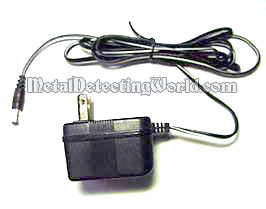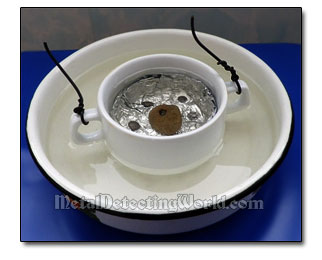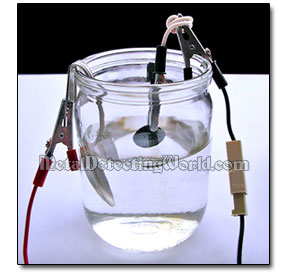A Complete Guide To Cleaning and Preservation of Coins, page 15
How To Clean Coins by Electrochemical Reduction and Electrolysis: Concept and Design
Electrochemical Reduction - Galvanic Cleaning, and Electrolytic Reduction - Electrolysis, are two quite effective methods for cleaning silver coins. Both methods are based on a Reduction half-reaction (an Oxidation half-reaction takes place simultaneously; redox reactions being a matched set); however, in Galvanic cleaning, the silver coins get cleaned by means of the metal reduction (see details below), and in Electrolysis, the coins are cleaned by mechanical action of hydrogen gas which, after being reduced, evolves off their surfaces. While the galvanic cleaning is a spontaneous redox reaction that can be sped up by applying heat, the electrolytic cleaning requires use of a direct electric current (DC) to drive an otherwise non-spontaneous redox chemical reaction.
The galvanic cleaning of coins is simpler, safer and more cost-effective than the electrolytic cleaning and always precedes the latter because the most the galvanic cleaning can do is to rid silver coins of black tarnish. The hard-encrusted silver coins should be subjected to electrolysis. Copper and copper-alloyed coins should NOT be subjected to either of these two cleaning methods for reasons given in each corresponding tutorial (links will be given below soon).
1. Electrochemical Reduction - GALVANIC CLEANING
Reduction is the decomposition of oxidation on the coin surfaces by separation of the oxygen, chlorine, sulfur, etc., from the compounds of oxygen, chlorine, sulfur, etc. making up the oxidation or corrosion. This method is based upon the galvanic current formed by the contact of two different metals.
The direction of the current in a solution is from the minus to the plus metal, corresponding to the Electromotive Force Series (EMF) in which metals are arranged according to their Standard Oxidation-Reduction Potentials:
| Gold (Au) | +1.40 Volt |
| Silver (Ag) | +0.80 Volt |
| Copper (Cu) | +0.34
Volt |
| Hydrogen (H) | 0 Volt |
| Lead (Pb) | -0.12 Volt |
| Tin (Sn) | -0.14 Volt |
| Iron (Fe) | -0.44 Volt |
| Zinc (Zn) | -0.76 Volt |
| Aluminum (Al) | -1.66 Volt |
Each of the metals exemplified above can be electrically positive or negative, depending upon whether it contacts a metal above or below it in the series. For example, if iron and zinc are placed in a caustic soda solution, iron is the negative and zinc is the positive pole of galvanic cell.
In case of reduction with zinc and sodium hydroxide, the copper coins are laid between zinc chips, over which 5% sodium hydroxide (caution: caustic soda) solution is added; it must completely cover the zinc. The coins should not touch one another.
According to the electromotive series, a current flows between the metals, reducing the metallic part of the deposit on the copper to metallic part copper, and loosening it. The zinc oxide that occurs as part of the deposit on the zinc is dissolved in the sodium hydroxide.
This method can be done with other metals and liquids too, keeping in mind the electromotive series. The Electrochemical Reduction method for removing tarnish off silver coins will be described in details in my Tutorial:
GALVANIC CLEANING OF SILVER COINS - Tutorial
2. Electrolytic Reduction - ELECTROLYSIS: Concept, Design and Detailed Tutorial
Electrolysis is the chemical decomposition of suitable materials by direct electric current. This cleaning method is used as "a last resort" on coins that have adhering hard encrustation and/or other hard-to-remove deposits on them, and all other cleaning methods such as soaking in olive oil, repeated deionized water soaking/scrubbing/picking, distilled water boils/freezes, ammonia bath, lemon acid treatment, immersion into hot bath of lemon juice and olive oil, and galvanic reduction cleaning failed to remove them. An example would be silver coins oxidized from long-term submersion in salt water. Copper-base and other highly corrosive metal alloyed coins should not be cleaned using electrolysis.
As the direct electric current decomposes the water into the constituents of hydrogen and oxygen, a reduction half-reaction begins immediately at the coin surface, manifesting itself by evolution of hydrogen bubbles. The hydrogen evolvement works mechanically on both the encrustation and the coin's patina, by breaking them off.
 />
/>If you are planning just to zap dug clad coins, you can make a simple electrolysis cleaner with a few household items and inexpensive parts:
1) an AC/DC converter or an adapter from any old household device such as a transistor radio or a telephone base capable of 400-700mA (milliampere) output
2) two "alligator" clips of the solderless type with the screw clamp for the wire (they can be purchased from your local electronics or hardware store)
3) a medium size glass or porcelain container
4) a stainless steel spoon or fork to be used as an electrode (anode)
5) solution of baking soda (or washing soda) and water as an electrolyte
Attach one clip to each of the two wires from the converter. If you know which wire is the positive lead, mark it as such (red). If the alligator clips came with colored rubber boots, slide the red one over the positive (+) wire/clip assembly.
Partly submerge the spoon upright in the glass container and clamp it to one side of the container using the positive (+) (anode) alligator clip. Place the edge of the coin to be cleaned in the jaws of the negative (-) (cathode) alligator clip.
NOTE 1: Be aware that the alligator clip may put marks into the coin's surface; however, a good metal-to-metal contact is required for electrolysis to work.
Submerge the coin in the Baking Soda/Water solution (electrolyte) to the tip of the alligator clip. DO NOT let the spoon touch the coin! Plug the converter into a AC wall outlet, the solution around the coin will start to bubble. Dirt and oxidation will immediately leave the coin and darken the electrolyte solution.
If this reaction does not take place, it is probably because you were unsure of the output wire polarity, there is no contact between the coin and cathode - the electric circuit is not complete, or your converter is simply not functioning. Swap clips on the spoon and coin and try again: however, if you do not want to destroy the coin, you need to watch the correct polarity of your electrolysis device. If you connect your coin to the positive ANODE electrode, the surface of the coin will start to deteriorate, and eventually the coin will be "consumed"!. NEVER TOUCH THE CLIPS TOGETHER, ALWAYS UNPLUG THE CONVERTER FROM THE WALL OUTLET FIRST!
NOTE 2: Do not use the same bath for silver, copper and nickel coins.
NOTE 3: I'm going to publish my 50-picture detailed tutorial "Electrolytic Cleaning of Coins" sometime soon. If you want to learn all technicalities of the method, avoid mishaps during the process, and clean your coins in a more efficient way, read my tutorial which will contain lots of detailed information on How To Build a Simple Home Electrolysis Machine of a "Classic" and "Pipe" types, How To Operate the Electrolytic Reduction System, What Coins To Clean with Electrolysis, Safety, and more.
CLEANING COINS with ELECTROLYSIS - Tutorial
3. SOAKING After Galvanic or Electrolytic Cleaning
A. After a chemical treatment coins should be soaked about a half-hour.
B. The coins never should lie still for long periods in tap water or even distilled water because chemical residues on the coins or deposits on the bottom of the vessel can cause attacks which may be evidenced as discoloration.
C. The coins never should lie on top of each other, because this can cause precipitation from the action of galvanic current, described in the "Electrochemical Reduction" part above. This is certainly true for coins of different metals, and may be true also for coins of apparently similar metal, but of different alloys.
For instance, if several silver coins lying partly one on top of the other are allowed to remain in tap water for a long while, "shadow images" will certainly form on the coins.
D. Silver and bronze coins should not be soaked together, as chemical reactions between the two metals can change the color of the silver.
E. The water should be changed every 10 minutes, turning over the coins at the same time. The tap water might be considerably contaminated with substances that can become active during the soaking, therefore, the distilled water is preferable.

